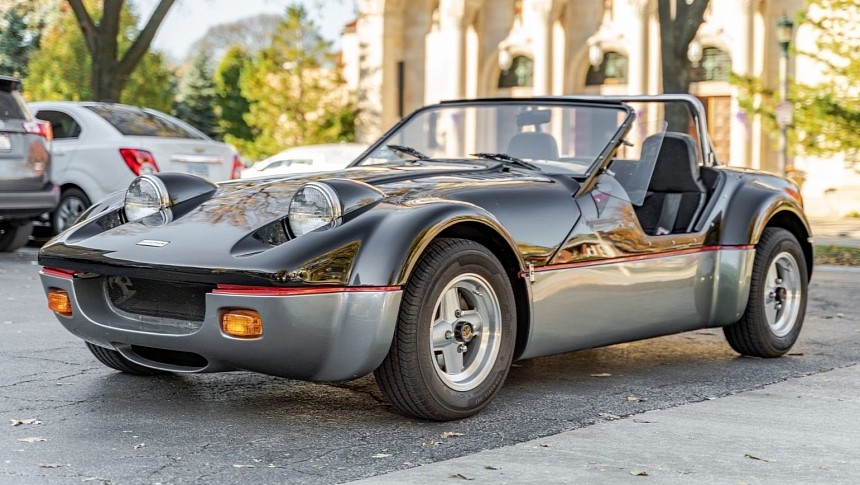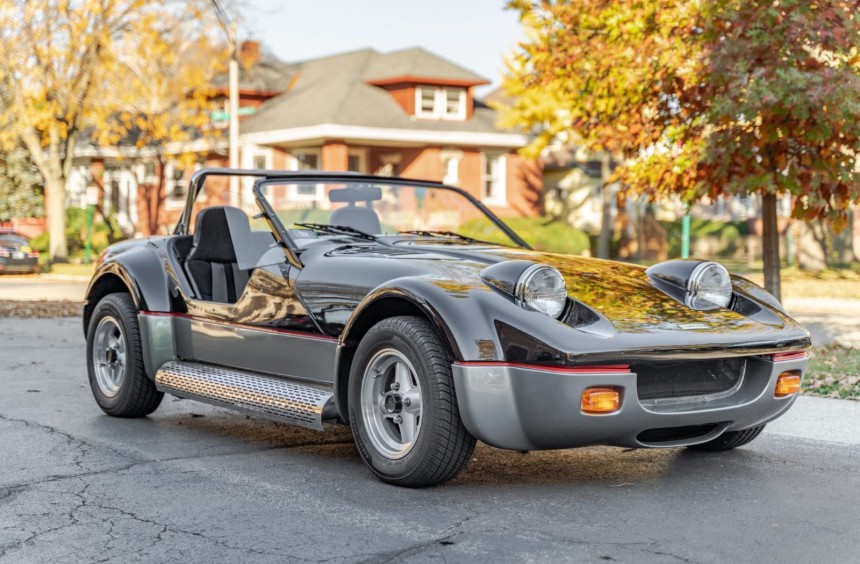Developed in Colorado during the 1980s, the Rollerskate was a relatively affordable, back-to-basics sports car that combined a small, lightweight chassis with one of the most advanced powertrains available at the time.
The basic recipe that makes a sports car great contains three main ingredients: a lightweight chassis, a powerful engine positioned as close to the middle of the chassis as possible, and a good suspension system that makes the whole thing handle right.
As simple as it may sound, manufacturers often complicate things to deliver safer, more technologically-advanced sports cars. Of course, some exceptions have followed the abovementioned recipe without adding unnecessary ingredients, which gave birth to legendary driver's cars.
Probably the most famous is the Lotus Seven, a timeless piece of straightforward yet clever engineering. It felt and looked like a race car, but it was affordable, easy to maintain, and completely street-legal. Lotus ceased production in 1973, but Caterham took over the blueprints and continued building this awesome car which is still around today.
The Seven was part of a special breed of lightweight British sports cars that fascinated many enthusiasts all over the world during the 1950 and 1960s. One of these enthusiasts was Bob Sutherland, a Colorado businessman, vintage car collector, and amateur race driver who decided to build an American lightweight roadster.
Sutherland had made enough money in the lumber industry to pursue this dream and didn't settle for a personal project car. He wanted a modern machine that drew inspiration from the British lightweight classics, but he also wanted to make it available to the average enthusiast for a competitive price.
To do that, he founded a company called Maxton and recruited a small team of out-of-the-box thinkers. Designer Mike Mate was in charge of designing a featherlight fiberglass body. Ben van der Linden, a talented race car engineer, developed the chassis and adapted the powertrain, while Gary Valler worked on the suspension. Finally, former race driver and successful businessman Dan Ripley handled testing and oversaw the manufacturing process.
The car they put together was christened Rollerskate. It was tiny and basic but performed exceptionally well, even in early prototype form. Encouraged by the early results, the Maxton team planned an initial production run of 50 units. However, emission and safety regulations prevented them from homologating the car for street use, and the only way to legally sell it was as a kit car.
After years of prototyping and testing, the car was ready for production in late-1992. Autoweek and Grassroots Motorsport were invited to put it to the test, and both magazines ended up publishing very positive reviews.
The Rollerskate was built around a square tube steel chassis that drew inspiration from the Lotus/ Caterham Seven. It was as light as possible and featured an independent suspension system with fully adjustable shocks on all four corners and multiple components sourced from Ford. The brakes and steering rack also came with Blue Oval badges, being borrowed from the Mustang II assembly line.
Close to the middle of the chassis, between the front axle and the passenger compartment, the team fitted a 13B twin-rotor engine linked to a five-speed manual. The powertrain came from the FC Mazda RX-7 and delivered sufficient power for the 1,680 lbs. (762 kg) track toy, so it was not tinkered with. However, with a wide range of aftermarket parts readily available, customers could quickly get plenty of extra horses with just a few bolt-on kits and a solid remap.
But even in stock form, the Rollerskate could accelerate from 0 to 60 mph (97 kph) in 5.5 seconds. Better yet, those fortunate to drive it on a proper race track were in awe of its maneuverability. According to multiple accounts, the tighter the corner, the better it performed.
Manufactured at Maxton's factory in Englewood, Colorado, the Rollerskate was introduced in 1993 and could be had for anywhere between $22,000 and $25,000 ($45,954- $52,220 today), depending on the options. Initially, it was available as a kit car that was delivered partially assembled and required about 50 hours to put together – not counting paintwork. Complete, ready-to-run vehicles could also be subsequently purchased from third parties, but that drove the price up by several thousand.
Reasonably cheap for the thrilling, unfiltered sports car experience it offered, the Rollerskate should have been a commercial success. Unfortunately, like many other great cars that failed to reach their potential in terms of sales, it hit the market during a period of great financial turmoil.
Interest in new sports cars, as well as vintage collectibles, dropped significantly during the early 1990s. To make matters worse, Maxton never had a dealership network or strong marketing department to promote the car properly.
Thus, the company struggled to sell the 50 Rollerskate that it ultimately managed to build and didn't follow up with another production run. Things were so bad that some examples that failed to sell were given away for free to loyal employees from the Sutherland Lumber Company.
These days, the Maxton Rollerskate is virtually unknown to everyone but a few die-heart enthusiasts. Almost every unit is accounted for, and in recent years, their value has increased.
Currently, a well-kept example with low mileage can be had for around $15,000, making it a bargain for those looking for a rare track toy that's easy to maintain and has huge tuning potential.
The black car featured in the gallery is one such example. In excellent shape and with only 5,000 miles (8,046 km) on the odometer, it was recently listed on the Bring a Trailer platform for around $16,000.
While it wasn't a marketing success, the Maxton Rollerskate is a terrific rotary-powered lightweight roadster built in the US. Even if it's 30 years old, it deserves more recognition and serious consideration from those who want a pure, back-to-the-basics sports car.
In 1992, MotorWeek received a Rollerskate kit and documented the building process. You can watch the first part of the series below, and be sure to check the MotorWeek channel for the following four parts.
As simple as it may sound, manufacturers often complicate things to deliver safer, more technologically-advanced sports cars. Of course, some exceptions have followed the abovementioned recipe without adding unnecessary ingredients, which gave birth to legendary driver's cars.
Probably the most famous is the Lotus Seven, a timeless piece of straightforward yet clever engineering. It felt and looked like a race car, but it was affordable, easy to maintain, and completely street-legal. Lotus ceased production in 1973, but Caterham took over the blueprints and continued building this awesome car which is still around today.
The Seven was part of a special breed of lightweight British sports cars that fascinated many enthusiasts all over the world during the 1950 and 1960s. One of these enthusiasts was Bob Sutherland, a Colorado businessman, vintage car collector, and amateur race driver who decided to build an American lightweight roadster.
How it all started
To do that, he founded a company called Maxton and recruited a small team of out-of-the-box thinkers. Designer Mike Mate was in charge of designing a featherlight fiberglass body. Ben van der Linden, a talented race car engineer, developed the chassis and adapted the powertrain, while Gary Valler worked on the suspension. Finally, former race driver and successful businessman Dan Ripley handled testing and oversaw the manufacturing process.
The car they put together was christened Rollerskate. It was tiny and basic but performed exceptionally well, even in early prototype form. Encouraged by the early results, the Maxton team planned an initial production run of 50 units. However, emission and safety regulations prevented them from homologating the car for street use, and the only way to legally sell it was as a kit car.
A closer look at the Rollerskate
The Rollerskate was built around a square tube steel chassis that drew inspiration from the Lotus/ Caterham Seven. It was as light as possible and featured an independent suspension system with fully adjustable shocks on all four corners and multiple components sourced from Ford. The brakes and steering rack also came with Blue Oval badges, being borrowed from the Mustang II assembly line.
Close to the middle of the chassis, between the front axle and the passenger compartment, the team fitted a 13B twin-rotor engine linked to a five-speed manual. The powertrain came from the FC Mazda RX-7 and delivered sufficient power for the 1,680 lbs. (762 kg) track toy, so it was not tinkered with. However, with a wide range of aftermarket parts readily available, customers could quickly get plenty of extra horses with just a few bolt-on kits and a solid remap.
But even in stock form, the Rollerskate could accelerate from 0 to 60 mph (97 kph) in 5.5 seconds. Better yet, those fortunate to drive it on a proper race track were in awe of its maneuverability. According to multiple accounts, the tighter the corner, the better it performed.
Struggling to sell
Reasonably cheap for the thrilling, unfiltered sports car experience it offered, the Rollerskate should have been a commercial success. Unfortunately, like many other great cars that failed to reach their potential in terms of sales, it hit the market during a period of great financial turmoil.
Interest in new sports cars, as well as vintage collectibles, dropped significantly during the early 1990s. To make matters worse, Maxton never had a dealership network or strong marketing department to promote the car properly.
Thus, the company struggled to sell the 50 Rollerskate that it ultimately managed to build and didn't follow up with another production run. Things were so bad that some examples that failed to sell were given away for free to loyal employees from the Sutherland Lumber Company.
The Rollerskate today
Currently, a well-kept example with low mileage can be had for around $15,000, making it a bargain for those looking for a rare track toy that's easy to maintain and has huge tuning potential.
The black car featured in the gallery is one such example. In excellent shape and with only 5,000 miles (8,046 km) on the odometer, it was recently listed on the Bring a Trailer platform for around $16,000.
While it wasn't a marketing success, the Maxton Rollerskate is a terrific rotary-powered lightweight roadster built in the US. Even if it's 30 years old, it deserves more recognition and serious consideration from those who want a pure, back-to-the-basics sports car.
In 1992, MotorWeek received a Rollerskate kit and documented the building process. You can watch the first part of the series below, and be sure to check the MotorWeek channel for the following four parts.


















